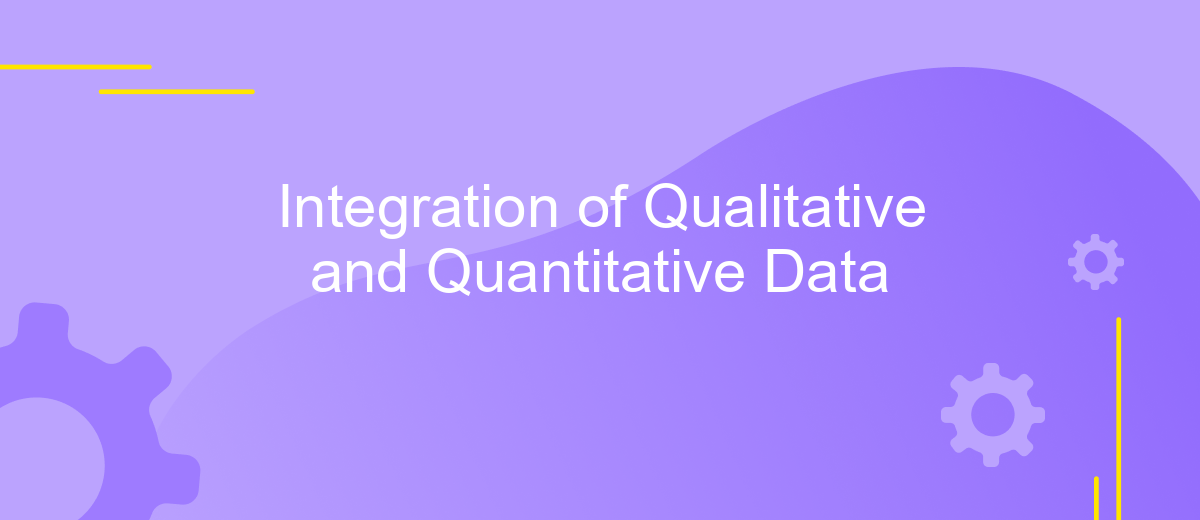Integration of Qualitative and Quantitative Data
In today's data-driven world, the integration of qualitative and quantitative data offers a comprehensive approach to research and decision-making. By combining the depth of qualitative insights with the breadth of quantitative analysis, organizations can gain a more nuanced understanding of complex issues. This article explores the benefits, challenges, and methodologies for effectively merging these two types of data.
Introduction
The integration of qualitative and quantitative data is a crucial approach in contemporary research, offering a comprehensive understanding of complex phenomena. By combining these two methodologies, researchers can leverage the strengths of both to provide a more nuanced and complete picture of the subject under study. This mixed-methods approach not only enhances the validity of the findings but also allows for a deeper exploration of research questions.
- Qualitative data provides rich, detailed insights through interviews, focus groups, and observations.
- Quantitative data offers statistical power and generalizability through surveys, experiments, and numerical analysis.
- Combining both methods facilitates triangulation, increasing the reliability of the results.
In this article, we will explore the methodologies for integrating qualitative and quantitative data, discuss the benefits and challenges of this approach, and provide practical examples from various fields of study. By understanding the synergy between these two types of data, researchers can unlock new perspectives and drive innovation in their respective domains.
Integration Strategies

Effective integration of qualitative and quantitative data requires a strategic approach that ensures both types of data complement each other. One common strategy is triangulation, where multiple data sources are used to cross-verify results, enhancing the validity and reliability of the findings. Additionally, data transformation techniques, such as quantifying qualitative data or contextualizing quantitative data with qualitative insights, can provide a more comprehensive understanding of the research problem.
Leveraging modern integration tools like ApiX-Drive can streamline the process by automating data collection and synchronization from various sources. ApiX-Drive allows for seamless integration of diverse data types, enabling researchers to focus on analysis rather than data management. By using such tools, the integration process becomes more efficient and less prone to human error, ultimately leading to more robust and actionable insights.
Methods of Integration

The integration of qualitative and quantitative data is essential for comprehensive research analysis. This approach allows for the validation of findings, cross-verification, and the development of a more nuanced understanding of the research problem. By combining these methods, researchers can leverage the strengths of both qualitative insights and quantitative rigor, thereby enhancing the reliability and depth of their conclusions.
- Data Triangulation: This involves using multiple data sources or methods to cross-check and validate findings. It helps in identifying consistencies and discrepancies across different types of data.
- Sequential Explanatory Design: In this method, quantitative data collection and analysis are followed by qualitative data collection and analysis. The qualitative phase helps to explain and interpret the quantitative results.
- Embedded Design: This approach integrates qualitative and quantitative data within a single study, where one type of data provides a supportive, secondary role to the other.
Each method of integration has its unique advantages and is chosen based on the specific research objectives and questions. By thoughtfully combining qualitative and quantitative approaches, researchers can achieve a richer, more comprehensive understanding of their study subjects, leading to more robust and actionable insights.
Benefits of Integration

The integration of qualitative and quantitative data offers a comprehensive approach to research, allowing for a richer and more nuanced understanding of complex phenomena. By combining these two methodologies, researchers can leverage the strengths of each to enhance the validity and reliability of their findings.
Qualitative data provides context and depth, capturing the intricacies of human experiences and behaviors. Quantitative data, on the other hand, offers generalizability and the ability to identify patterns and relationships through statistical analysis. Together, they create a more holistic view of the research subject.
- Enhanced data validation through triangulation
- Improved insights by combining numerical data with contextual narratives
- Greater ability to address research questions from multiple perspectives
- Increased robustness of findings through methodological diversity
Ultimately, the integration of qualitative and quantitative data enables researchers to draw more comprehensive and actionable conclusions. This blended approach not only enriches the research process but also facilitates more informed decision-making in both academic and practical applications.
- Automate the work of an online store or landing
- Empower through integration
- Don't spend money on programmers and integrators
- Save time by automating routine tasks
Conclusion
The integration of qualitative and quantitative data offers a comprehensive approach to understanding complex phenomena. By combining the depth of qualitative insights with the breadth of quantitative analysis, researchers and organizations can achieve a more nuanced and complete picture of their subject matter. This dual approach enables the identification of patterns and trends that might be overlooked when using a single method, thus enhancing the reliability and validity of the findings.
Tools like ApiX-Drive facilitate this integration by automating data collection and synchronization from various sources. Such services streamline the process, allowing for seamless integration of diverse data types without the need for extensive manual intervention. As a result, stakeholders can focus more on analysis and decision-making rather than on the technicalities of data management. Ultimately, the integration of qualitative and quantitative data, supported by robust tools, empowers more informed and strategic decisions in both academic and professional contexts.
FAQ
What is the importance of integrating qualitative and quantitative data?
How can I effectively combine qualitative and quantitative data in my research?
What are some common challenges in integrating qualitative and quantitative data?
How can automation tools help in the integration of qualitative and quantitative data?
What are some best practices for ensuring data quality when integrating qualitative and quantitative data?
Apix-Drive is a universal tool that will quickly streamline any workflow, freeing you from routine and possible financial losses. Try ApiX-Drive in action and see how useful it is for you personally. In the meantime, when you are setting up connections between systems, think about where you are investing your free time, because now you will have much more of it.


